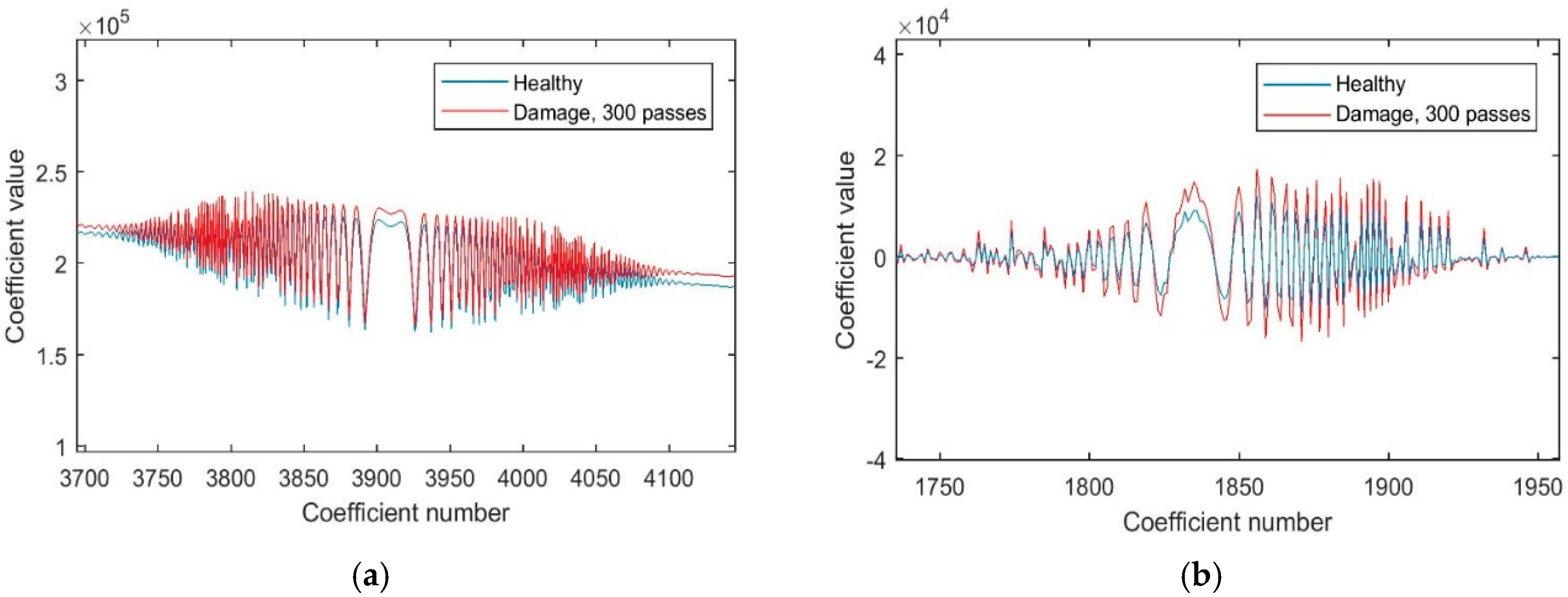Tool Condition Monitoring in Grinding Operation Using Piezoelectric Impedance and Wavelet Transform †
Abstract
:1. Introduction
2. Experimental Setup
3. Results and Discussions
3.1. Tool Wear Analysis
3.2. Discrete Wavelet Analysis Based on EMI for Tool Condition Monitoring
4. Conclusions
Author Contributions
Funding
Acknowledgments
Conflicts of Interest
References
- Pombo, I.; Cearsolo, X.; Sánchez, J.A.; Cabanes, I. Experimental and numerical analysis of thermal phenomena in the wear of single point diamond dressing tools. J. Manuf. Process. 2017, 27, 145–157. [Google Scholar] [CrossRef]
- Alexandre, F.A.; Lopes, W.N.; Dotto, F.R.L.; Ferreira, F.I.; Aguiar, P.R.; Bianchi, E.C.; Lopes, J.C.; Aguiar, P.R. Tool condition monitoring of aluminum oxide grinding wheel using AE and fuzzy model. Int. J. Adv. Manuf. Technol. 2018, 96, 67–79. [Google Scholar] [CrossRef]
- Alexandre, F.; de Aguiar, P.; Götz, R.; Aulestia Viera, M.; Lopes, T.; D’addona, D.; Bianchi, E.; da Silva, R.B. Emitter-Receiver Piezoelectric Transducers Applied in Monitoring Material Removal of Workpiece during Grinding Process. Proceedings 2019, 4, 9. [Google Scholar]
- Oliveira Junior, P.; Ferreira, F.I.; Aguiar, P.R.; Batista, F.G.; Bianchi, E.C.; Daddona, D.M. Time-domain Analysis Based on the Electromechanical Impedance Method for Monitoring of the Dressing Operation. Procedia CIRP 2018, 67, 319–324. [Google Scholar] [CrossRef]
- Martins, C.H.R.; Aguiar, P.R.; Frech, A.; Bianchi, E.C. Tool Condition Monitoring of Single-Point Dresser Using Acoustic Emission and Neural Networks Models. IEEE Trans. Instrum. Meas. 2014, 63, 667–679. [Google Scholar] [CrossRef]
- Miranda, H.I.; Rocha, C.A.; Oliveira Junior, P.; Martins, C.; Aguiar, P.R.; Bianchi, E.C. Monitoring single-point dressers using fuzzy models. Procedia CIRP 2015, 33, 281–286. [Google Scholar] [CrossRef]
- Oliveira Junior, P.; Marchi, M.; Martins, C.H.R.; D’Addona, D.; de Aguiar, P.R.; Bianchi, E.C. Spectral estimation of vibration signal for monitoring the wear of single-point dresser. Rev. Mater. 2016, 21, 827–840. [Google Scholar]
- D’Addona, D.M.A.; Lopes, S.C.W.N.; Aguiar, P.R.; Bianchi, E.C.; Teti, R. Tool condition monitoring of single-point dressing operation by digital signal processing of AE and AI. Procedia CIRP 2018, 67, 307–312. [Google Scholar] [CrossRef]
- Junior, P.; D’Addona, D.M.; Aguiar, P.R. Dressing Tool Condition Monitoring through Impedance-Based Sensors: Part 1—PZT Diaphragm Transducer Response and EMI Sensing Technique. Sensors 2018, 18, 4455. [Google Scholar] [CrossRef]
- Oliveira Junior, P.; D’Addona, D.; Aguiar, P.; Teti, R. Dressing Tool Condition Monitoring through Impedance-Based Sensors: Part 2—Neural Networks and K-Nearest Neighbor Classifier Approach. Sensors 2018, 18, 4453. [Google Scholar] [CrossRef]
- Baptista, F.G.; Vieira, J.F. A new impedance measurement system for PZT based structural health monitoring. IEEE Trans. Instrum. Meas. 2009, 58, 3602–3608. [Google Scholar] [CrossRef]
- Castro, B.A.; Baptista, F.G.; Ciampa, F. Comparative analysis of signal processing techniques for impedance-based SHM applications in noisy environments. Mech. Syst. Signal Process. 2019, 126, 326–340. [Google Scholar] [CrossRef]
- Inman, D.J.; Vieira, J.; Guimar, F. Time-domain analysis of piezoelectric impedance-based structural health monitoring using multilevel wavelet decomposition. Mach. Syst. Signal Process. 2011, 25, 1550–1558. [Google Scholar]
- Grabowska, J.; Palacz, M.; Krawczuk, M. Damage identification by wavelet analysis. Mech. Syst. Signal Process. 2008, 22, 1623–1635. [Google Scholar] [CrossRef]
- Oliveira Junior, P.; Souza Ruzzi, R.; Lopes, W.N.; Alexandre, F.A.; Baptista, F.G.; de Aguiar, P.R.; Bianchi, E.C. A New Approach For Dressing Operation Monitoring Using Voltage Signals Via Impedance-Based Structural Health Monitoring. KnE Eng. 2018, 942–952. [Google Scholar] [CrossRef]
- Oliveira Junior, P.; Conte, S.; D’Addona, D.M.; Aguiar, P.R.; Baptista, F.G.; Bianchi, E.C.; Teti, R. Damage patterns recognition in dressing tools using PZT-based SHM and MLP networks. Procedia CIRP 2019, 79, 303–307. [Google Scholar] [CrossRef]



| Dressing passes | 100 | 200 | 300 |
| Tool wear (%) | 28% | 55% | 100% |
Publisher’s Note: MDPI stays neutral with regard to jurisdictional claims in published maps and institutional affiliations. |
© 2019 by the authors. Licensee MDPI, Basel, Switzerland. This article is an open access article distributed under the terms and conditions of the Creative Commons Attribution (CC BY) license (https://creativecommons.org/licenses/by/4.0/).
Share and Cite
Junior, P.O.; Aguiar, P.; Ruzzi, R.; Conte, S.; Viera, M.; Alexandre, F.; Baptista, F.; Júnior, a.C.S. Tool Condition Monitoring in Grinding Operation Using Piezoelectric Impedance and Wavelet Transform. Proceedings 2020, 42, 10. https://doi.org/10.3390/ecsa-6-06589
Junior PO, Aguiar P, Ruzzi R, Conte S, Viera M, Alexandre F, Baptista F, Júnior aCS. Tool Condition Monitoring in Grinding Operation Using Piezoelectric Impedance and Wavelet Transform. Proceedings. 2020; 42(1):10. https://doi.org/10.3390/ecsa-6-06589
Chicago/Turabian StyleJunior, Pedro Oliveira, Paulo Aguiar, Rodrigo Ruzzi, Salvatore Conte, Martin Viera, Felipe Alexandre, Fabricio Baptista, and and Cristiano Soares Júnior. 2020. "Tool Condition Monitoring in Grinding Operation Using Piezoelectric Impedance and Wavelet Transform" Proceedings 42, no. 1: 10. https://doi.org/10.3390/ecsa-6-06589
APA StyleJunior, P. O., Aguiar, P., Ruzzi, R., Conte, S., Viera, M., Alexandre, F., Baptista, F., & Júnior, a. C. S. (2020). Tool Condition Monitoring in Grinding Operation Using Piezoelectric Impedance and Wavelet Transform. Proceedings, 42(1), 10. https://doi.org/10.3390/ecsa-6-06589








